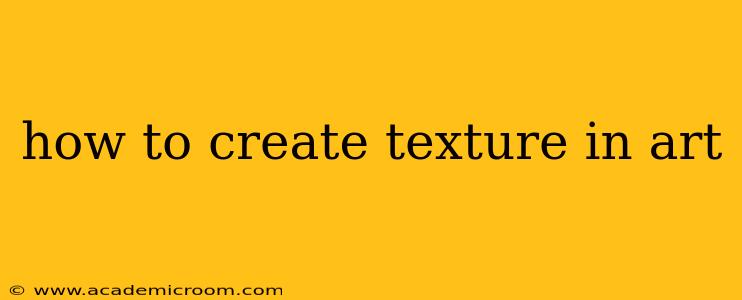Creating texture in art is a fundamental skill that elevates a piece from flat representation to a captivating, three-dimensional experience. Whether you're working with paint, sculpture, digital media, or other mediums, understanding how to effectively represent or create tactile sensations is key to impactful artwork. This guide will explore various techniques and approaches for achieving realistic and expressive textures in your art.
What is Texture in Art?
Texture in art refers to the surface quality of an artwork, both real and implied. Real texture is the actual physical surface; you can feel it with your fingers. Think of the rough surface of a heavily impastoed oil painting or the smooth coolness of a polished sculpture. Implied texture is the illusion of texture created on a flat surface. A painting might depict the softness of fur or the roughness of bark, even though the canvas itself is smooth. Mastering both is crucial for a compelling piece.
Different Ways to Create Texture in Various Art Forms
Painting:
-
Impasto: This technique involves applying thick layers of paint to the canvas, creating a raised, textured surface. The visible brushstrokes and ridges add depth and visual interest. Experiment with palette knives for even more dramatic effects.
-
Dry Brushing: Using a nearly dry brush with a minimal amount of paint creates a scratchy, broken texture, ideal for depicting weathered surfaces, fur, or dry leaves.
-
Sgraffito: Scratching through layers of wet paint to reveal underlying colors creates a unique textural effect. This works particularly well with acrylics or tempera.
-
Layering: Building up layers of thin washes or glazes can create subtle shifts in tone and implied texture. The overlapping layers can suggest depth and a sense of age.
-
Techniques Specific to Mediums: Oil paints allow for heavier impasto than watercolors, while acrylics offer a versatile range of textures depending on the application technique and mediums used.
Sculpture:
-
Additive Sculpting: Techniques like modeling clay, wax carving, or building with found objects create three-dimensional texture directly.
-
Subtractive Sculpting: Carving techniques such as whittling or chiseling remove material to reveal underlying forms and textures.
-
Mixed Media Sculptures: Combining different materials—wood, metal, fabric, etc.—allows for complex and varied textures in a single piece.
Drawing:
-
Cross-Hatching: Overlapping lines create a sense of depth and shadow, simulating different textures. Varying the pressure and spacing of lines can create subtle differences in texture.
-
Stippling: Using dots of varying sizes and densities creates a textured effect. Closely spaced dots create a darker, smoother tone, while widely spaced dots give a lighter, rougher feeling.
-
Scumbling: A layering technique involving applying a light layer of pastel or charcoal over a darker underlayer, creating a soft, hazy texture.
Digital Art:
-
Textures: Using digital brushes, filters, and texture overlays can quickly add realism and visual interest.
-
Layer Effects: Experiment with layer blending modes to create depth and texture within your digital artwork.
-
3D Modeling: Creating 3D models allows for intricately detailed surfaces with highly realistic texture maps applied.
How to Choose the Right Texture for Your Art
The appropriate texture depends entirely on the subject matter, your artistic style, and the message you want to convey. A rough texture might be suitable for depicting a rugged landscape, while a smooth texture might be better for representing still water. Consider the emotional impact of different textures – harsh textures can evoke feelings of unease, while soft textures can create a sense of calm.
H2: What are some examples of different textures in art?
Examples of textures in art abound. Think of the smooth, almost glassy surface of a porcelain vase versus the coarse, roughly hewn texture of a wood carving. The subtle variations in a watercolor painting capturing a soft, velvety petal contrast sharply with the heavy impasto strokes in a Van Gogh landscape. Each texture contributes to the overall feeling and impact of the artwork.
H2: How can I practice creating texture in my art?
Practice is key to mastering texture. Start by experimenting with different techniques in your chosen medium. Copy master works, focusing on how the artists created various textures. Try using found objects and natural materials to inspire your texture exploration. Don't be afraid to make mistakes; experimentation is vital to discovering your own unique approach to texture.
H2: How important is texture in art?
Texture is an integral element of art, adding depth, visual interest, and emotional resonance. It can be used to enhance realism, express emotions, or create purely abstract effects. Mastering texture is a critical step in becoming a well-rounded artist.
By thoughtfully exploring and employing these techniques, you can add a new level of depth and engagement to your artwork, transforming your creations from simple images into truly tangible experiences.
